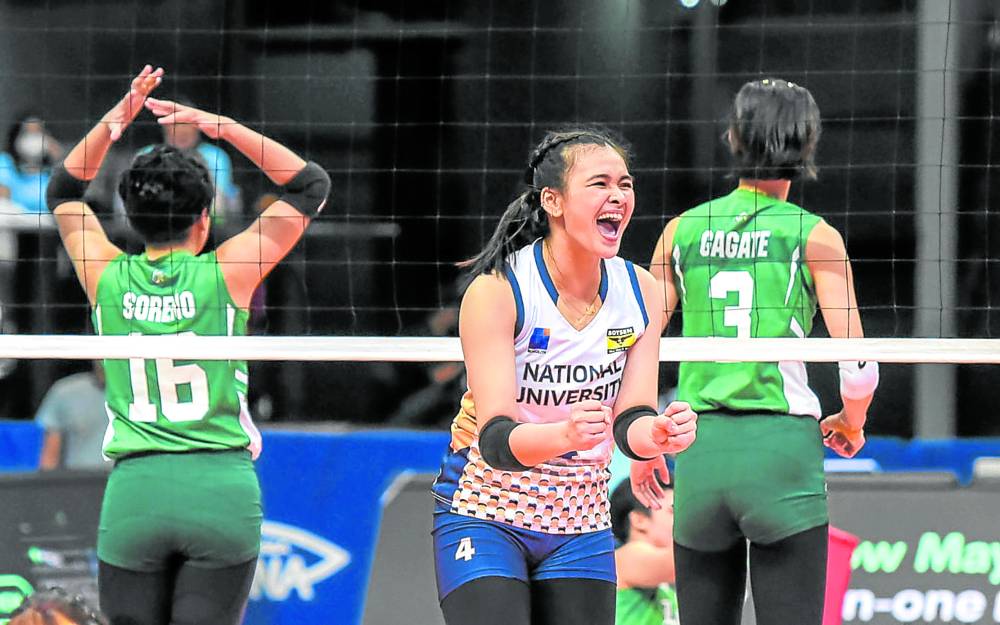
Mhicaela Belen (middle) will spearhead a young national pool even as the PNVF continues to engage other schools who have turned their backs to the call to be part of the national volleyball program. —UAAP MEDIA.
Stuck in the group of death in the Asian Volleyball Confederation (AVC) Cup for Women, the Philippine team is ready to go on a rebirth.
Led by the young and talented players from University Athletic Association of the Philippines (UAAP) champion National University, the latest iteration of the national women’s volleyball team will form the core of a program that hopes to pattern itself after regional powerhouse Thailand.
“We’re really thankful for the schools that released their players for the national team,” said Philippine National Volleyball Federation (PNVF) board member Ricky Palou. “This is the way we can build the future, by training these young kids and giving them the experience to play against top-notch opponents.”
The PNVF has yet to release the final composition of the squad that will be bunched with reigning champion China in Pool A of the tournament slated Aug. 21 to 29 at PhilSports Arena.
Among the names sure to make the team though are the stalwarts of the peerless Lady Bulldogs, who swept their way to the UAAP crown recently. Leading that pack are Mhicaela Belen, who hoarded the Rookie of the Year and Most Valuable Player trophies, Jen Nierva, Alyssa Solomon and Ivy Lacsina. UAAP schools like Ateneo and Adamson have also chipped in to the national pool.
“We’re really grateful to those schools who helped,” Palou said.
“This is a strong tournament and our young players, who we vision as the future of Philippine volleyball, will get the needed exposure against the continent’s best teams,” said PNVF president Tats Suzara.
Also in Pool A are powerhouse South Korea, Iran and Vietnam. Forming Pool B are Japan, the 2018 runner-up, Southeast Asia champion Thailand, Kazakhstan, Chinese Taipei and Australia.
Palou revealed that the PNVF continues engaging other schools who did not release their players, like La Salle and University of Santo Tomas, to the national program.
“We are in constant communication with them. We understand their concerns but hopefully, they’ll understand what we are trying to do here,” Palou added. “Right now, the players who have been released by their schools, these are the ones who will be the seeds of our program. We will start with them.”
The PNVF had earlier said that they are luring the collegiate leagues to become active stakeholders to the national program by allowing their players to join the women’s pool.
“That’s how Thailand became so strong. They started out training their varsity standouts, twice a day even. That’s five hours of daily practice,” Palou explained. “ We are hoping to replicate that in our own way and then two months or so before the collegiate leagues begin, we release the national pool members to their schools.”
Suzara, meanwhile, said the Philippines will learn a lot from competing in the tournament, even as fans will get to watch world-class volleyball anew on the heels of the country’s hosting of a Volleyball Nations League (VNL) leg.
“Just like the VNL, Filipino volleyball fans will again be treated to world-class volleyball action considering that world-ranked teams China, Japan, Iran, South Korea, and Thailand are playing,” he said.
China has dominated the AVC tournament, winning five of its six editions: Nakhon Ratchasima in 2008, Taicang in 2010, Shenzhen in 2014, Vinh Phuc in 2016 and Nakhon Ratchasima in 2018. Thailand won its lone title in Almaty in 2012.
The preliminary round is set from Aug. 21 to 25 with the Filipinos facing Vietnam on Aug.21, China on Aug. 23, Iran on Aug. 24, and South Korea on Aug. 25.
The knockout quarterfinals are set on Aug. 27 with the semifinals set for Aug. 28 and the qualification matches and final on Aug. 29.

